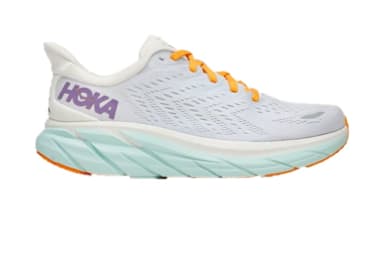
July 18, 2024
According to podiatrist Dina Gohil, DPM, “sciatica refers to pain that radiates along the path of the sciatic nerve [from the lower back down through the back of the leg]”—and yes, it can be extremely painful and intrusive.
The good news? While the wrong shoes can exacerbate sciatica, Gohil says, “shoes that provide proper support and cushioning can help alleviate pressure on the sciatic nerve and reduce symptoms” (yet another reason to prioritize your footwear).
Below, find the best shoes for sciatica based on research, testing, and podiatrist recommendations.
What is sciatica?
Sciatica is a syndrome that impacts your sciatic nerve (the thickest nerve in your body), which runs from the lower back through the hip, legs, calves, and feet. The sciatic nerve helps control the legs, feet, and toes, and has branches on both sides of the body.
Per Gohil, sciatica typically affects one side of the body, and it occurs when the sciatic nerve is impinged, compressed or irritated. Research shows sciatica cases peak for people in their forties2, with the lifetime incidence of sciatica reported to be between 10% and 40%.
Some studies suggest a genetic predisposition2 for sciatica, but people who spend a lot of time sitting or in unnatural positions could also be at a higher risk.
Symptoms of sciatica
Sciatica typically leads to a burning dull, or sharp pain that travels down the hip, side of the leg, calf, or foot. Below, find a few other common symptoms of sciatica.
- Tingling sensations in the toes and lower leg
- Lower back or hip pain and aching
Again, these symptoms topically present on one side of the body, depending on where the issue originates. Many people with sciatica feel more pain when lying flat, sitting or standing for long periods of time, or running.
How shoes help with sciatica
Your feet are at the foundation of your body, so it’s always important to pay attention to how supportive your shoes are—but people with sciatica need to pay extra attention in this area.
“Poorly fitting shoes or those lacking adequate support can exacerbate sciatica by placing strain on the lower back and aggravating nerve compression,” Gohil explains. “Conversely, shoes that provide proper support and cushioning can help alleviate pressure on the sciatic nerve and reduce symptoms.”
Considering the amount of time we spend in shoes, the right pair can make a difference in keeping your body healthy and pain-free.
Our selection criteria
There are a lot of factors to consider when choosing the best shoes for sciatica. Gohil says the below criteria is crucial to prioritize:
- Comfort: If you’re already experiencing pain from sciatica, it’s important to choose shoes that feels good on your feet. Every pair on our list has a generous return policy.
- Support: “Arch support plays a significant role in distributing weight evenly across the foot and maintaining proper alignment,” Gohil explains. “This helps reduce strain on the lower back and can alleviate sciatica symptoms by preventing excessive pronation or supination of the foot.”
- Cushioning: Per Gohil, you’ll want a cushioned sole to absorb shock—but the best shoes for sciatica also need an equally supportive heel counter to stabilize the foot.
The best shoes for sciatica
KLAW 528
Best for walking
Sizes
6-11, wide sizes available, some half sizes available
Pros & Cons
Pros
Designed with podiatrists and have the APMA Seal of Approval
Thick cushioning is extremely comfortable
Deep heel cup keeps your foot stable as you walk
Cons
Material might be too thick for very warm weather
Put simply: These shoes check all my boxes. Even better, they meet our podiatrist’s criteria for the best shoes for sciatica (which is not surprising considering the KLAW 528 walking shoes were designed with the help of another podiatrist, Nelya Lobkova).
With the American Podiatric Medical Association (APMA) seal of approval, the KLAW sneakers offer support along the entire arch of your foot. They also feature a deep heel cup to promote stability and stop your feet from tilting in and out while you’re walking.
I got 5 months of extensive (+12,000 steps per day) wear out of my first pair of KLAW walking shoes, and I’m already four months into my replacement pair. Aside from the influx of compliments I get when I wear my KLAWs, what I love most is that I can barely feel the ground beneath my feet (even on NYC pavement).
Editor’s note: These shoes are currently out of stock in most sizes, but you can join the waitlist to be alerted when they’re available again (trust me, the KLAWs are worth the wait).
-
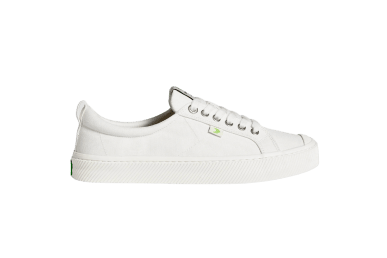
-
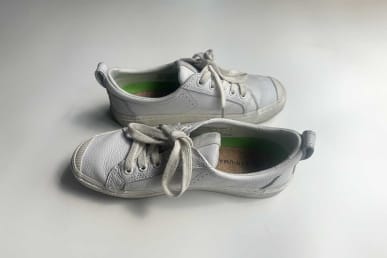
Image by Carleigh Ferrante / mbg creative
OCA Low by Cariuma
Best sustainable
Sizes
5-13; half sizes available
Pros & Cons
Pros
Made with vegan and sustainable materials
Lightweight and breathable
Supportive and comfortable enough for heavy walking days
Cons
You’ll want no-show socks
Leather style is not machine washable
Cariuma hits the nail on the head with sustainability (a tough feat in the footwear industry)—and these shoes don’t disappoint on support, either. The Oca low are a favorite of our editorial staff and they’re equally loved by our testers with wide feet and narrow feet, along with flat feet, neutral, or high arches.
What makes them so great? The Oca lows are lightweight, breathable, supportive, and so chic. They have a cork and bio-based foam footbed that molds to your feet and adds enough support for heavy walking days.
Depending on your level of sciatica pain or discomfort, you may prefer something with a bit of a thicker cushion, or you might want to remove the insole to use your own custom orthotics (which is very easy to do!).
I’m on my third pair of Cariuma Ocas and I love that they’re comfortable straight out of the box. Even on days when I walk more than 15,000 steps, I never feel discomfort from my Cariuma Ocas.
Most of all, I appreciate that these vegan white sneakers are made primarily with natural materials, including responsibly sourced rubber, recycled plastics, and organic cotton.
-
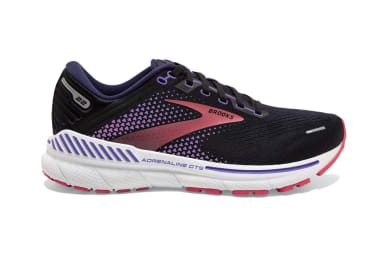
-
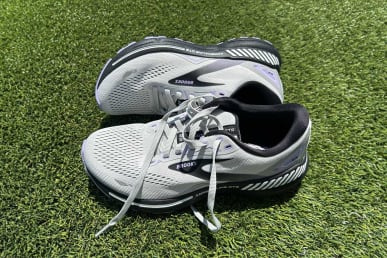
Image by Carleigh Ferrante / mbg creative
-

Image by Carleigh Ferrante / mbg creative
Adrenaline GTS 23 by Brooks
Best for knee pain
Pros & Cons
Pros
Uses the brand’s GuideRails technology to keep your foot in alignment
Highly cushioned but still feel lightweight
60% recycled materials in the upper
Exceptional stability and support
Cons
Some testers say they require a break-in period
Gohil says Brooks styles tend to have great cushioning and support for those with sciatica, and podiatrist Anne Sharkey, DPM previously recommended the Brooks Adrenaline GTS specifically for those with knee pain.
Overpronation can lead to knee pain when you don’t have the right shoes—but these shoes are a great choice for those who do need more stability, thanks to the brand’s GuideRails technology which keeps the foot in alignment as you walk or run.
Per Sharkey, these shoes also hit the mark for comfort and shock absorption. The cushioning is thick (12 mm), but not heavy.
I was first introduced to the Adrenaline sneakers when dealing with a bout of knee pain a few years back while marathon training, and my runner friends with sensitive knees all love this pick. What I notice most when testing these shoes was how smooth my stride felt over both long and short distances.
Hoka Clifton 9
Best for the gym
Sizes
5-12, half sizes available, wide sizes available
Pros & Cons
Pros
Responsive, shock-absorbing cushioning
Great for medium to high arches
Rocker-style shape helps evenly distribute your weight as you move
Cons
Some testers say they run large
The Hoka Clifton 9 sneakers are well-loved by runners walkers, gym-goers, and our editorial staff. Hoka’s signature ultra-cushioned rocker soles provide exceptional shock absorption—and the Clifton 9 in particular has the APMA seal of approval, indicating that it’s beneficial for foot health.
These shoes offer neutral support and cushioning throughout the midsole, an extended heel, and a wide toe box that makes it a great fit for people with bunions or metatarsal pain.
While we wouldn’t recommend them as a weightlifting shoe, they’re a great pick for other gym activities, as well as running, walking, or everyday wear.
Testers love how the thick cushioning helps absorb impact when running on harder surfaces, and these shoes get high praise for their stylish design as well. The best part? Testers with sciatica pain say these shoes help tremendously.
-
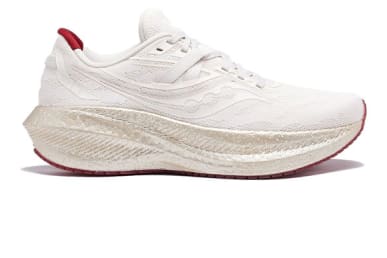
-
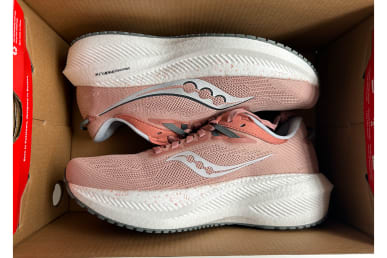
Image by Carleigh Ferrante / mbg creative
-
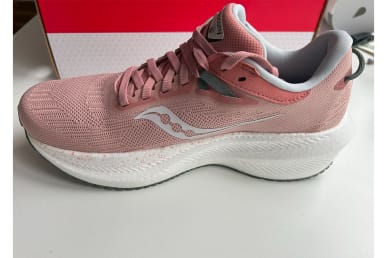
Image by Carleigh Ferrante / mbg creative
Saucony Triumph
Best for stability
Sizes
5-12, half sizes available
Pros & Cons
Pros
Very good traction for a variety of surfaces
Lightest sneaker on our list, but still have significant cushioning
Mold to your feet with a sock-like feel
Cons
Some testers experienced rubbing around the ankle
Gohil says arch support is crucial for sciatica pain relief, and these shoes offer plenty. In fact, podiatrist Hillary Brenner, DPM previously recommended the Saucony Triumph specifically for runners who need extra arch support.
The Saucony Triumph have a sock-like feel, with a secure fit and thick cushioning that gives them an added layer of stability as well. Plus, a wider toe box makes these a great pick for people with bunions, while the knit upper keeps these shoes feeling lightweight and breathable.
What really stood out to me while testing these shoes was how bouncy they felt during my long runs and my sprints on various surfaces—a feature I didn’t expect from a shoe that offers such great stability.
Bonus: These APMA certified sneakers have a 10 millimeter drop (on the higher end), but are the lightest design (8.6 ounces) out of all the shoes on the list.
Asics Gel Nimbus 26
Best for arch support
Sizes
5-13, half sizes available
Pros & Cons
Pros
Very breathable materials
Comfortable and supportive during long runs
Cons
Some testers say sizing runs slightly small
I’ve been running in the Asics Gel Nimbus sneakers for over 10 years, and they’ve supported me through bouts of knee pain, back pain, and bunion pain, not to mention extensive marathon training. But that’s just part of why we included these cult-favorite sneakers on our list.
The main reason? Gohil personally recommended Asics as one of her top picks for the best shoes for sciatica—and the Gel Nimbus sneakers are designed specifically for comfort, support, and shock absorption.
These shoes offer neutral support and maximum cushioning, made from the brand’s FF BLAST™ PLUS ECO material. The gripped outsole provides great traction for road running, while also adding to the shoe’s durability.
My favorite part? The Asics Gel Nimbus hold up extremely well over time. I replace them like clockwork every 400 to 500 miles, per podiatrist recommendations.
Bonus: At least 75% of the shoe’s upper is made with recycled content.
-

Image by New Balance / Zappos
-
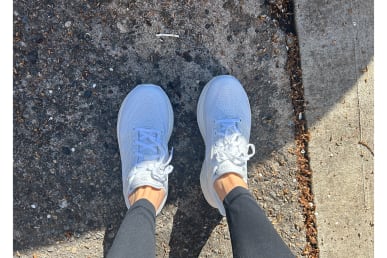
Image by Carleigh Ferrante / mbg creative
New Balance Fresh Foam X 1080v13
Best for beginner runners
Sizes
5-13, including half sizes, including narrow, wide, and x-wide sizes
Pros & Cons
Pros
Great underfoot cushioning & sufficient bounce
Sturdy design for those who need added stability
Cons
Some testers say the heel cup is too narrow
New to running and want to make sure you’re maintaining proper form and preventing pain? The New Balance Fresh Foam X 1080v13 are our favorite pick for beginner runners specifically. In fact, our editor who hated running had a total change of heart after testing these out—not to mention the brand says if it only made one running shoe it would be these.
What makes them so great? For starters, these shoes have the APMA seal of acceptance. Plus, they’re made with ample cushioning in the midsoles for a smooth heel-to-toe transition, and the breathable mesh upper is so flexible that it truly feels like an extension of your foot.
I never once feel discomfort in my feet, knees, or back while running in these sneakers—and the solid rubber outsole gives these shoes a sturdiness that other lightweight shoes lack (and Gohil says is essential for sciatica relief).
Of course, I’d be remiss not to mention that I run significantly faster in these sneakers.
Skechers GOwalk Joy
Best affordable
Sizes
5-13, half sizes available, wide sizes available, narrow sizes available
Pros & Cons
Pros
Lightweight, breathable mesh material
Testers say they are very durable through everyday wear
Most affordable price point on our list
Cons
Insoles are not removable
Some testers say they run large
This popular pick is proof that supportive shoes don’t need to cost an arm and a leg. The Skechers GoWalk Joy are a comfortable, durable, and affordable shoe that’s garnered thousands of reviews from avid walkers and people who spend long periods of time on their feet.
Even one 82-year-old tester with sciatica, neuropathy, and a knee replacement notes that she’s bought multiple pairs of these shoes because of how supportive and comfortable they are.
The removable Ortholite sole is made from PU foam and aerogel, which the brand says helps make the shoe’s cushioning last even longer.
More perks? These slip-on shoes are machine-washable and available in a wide variety of colors.
Vivaia Adaptable Sport Sandals
Best sandals
Sizes available
5-11, half sizes available
Pros & Cons
Pros
Made from recycled and sustainable materials
Great arch support and cushioning
Cons
Some reviewers say the straps feel tight on the top
Yup, your sandals need arch support too—and this chic pick meets all our standards. The Vivaia Adaptable Sports Sandals feature a foot-contoured construction to help evenly distribute pressure and reduce fatigue as you walk or stand.
They have a lush 30 millimeters of EVA cushioning and a 9 millimeter heel-to-toe drop, yet they’re surprisingly lightweight at just TK ounces. What’s more, the moisture-wicking insole helps keep your feet comfortable even during the hottest temperatures.
An anti-slip outsole makes these a great shoe for walking on all surfaces, while the brand’s AdaptAll Strap™ helps you find the perfect fit for your foot shape.
The cherry on top? These sandals are a sustainable choice, as they’re made from plastic water bottles.
Comparing the best shoes for sciatica
| Product | Price | Sizes available | Colorways | Drop | Weight |
|---|---|---|---|---|---|
| KLAW 528 | $148 | 6-11 | 5 | 7mm | 11 oz |
| Cariuma Oca Low | $85 | 5-13 | 16 | n/a | 11.2 oz |
| Brooks Adrenaline GTS 22 | $140 | 5-13 | 23 | 12mm | 10.2 oz |
| HOKA Clifton 8 | $145 | 5-12 | 20 | 8mm | 7.2 oz |
| Saucony Triumph | $118 | 5-12 | 15 | 10mm | 8.6 oz |
| ASICS Gel Nimbus | $160 | 5-13 | 19 | 11mm | 10.2 oz |
| New Balance Fresh Foam X 1080v13 | $165 | 5-13 | 15 | 6mm | 10.9 oz |
| Skechers GOwalk Joy | $65 | 5-13 | 6 | 9.5mm | 6.8 oz |
| Vivaia Adaptable Sport Sandals | $119 | 5-11 | 23 | 9mm | 6.91 oz |
FAQ:
What type of shoe is best for sciatica?
“I recommend shoes with excellent arch support, cushioning, and stability features,” says podiatrist Dina Gohil, DPM. She adds that “brands like Brooks, New Balance, and Asics offer models specifically designed for comfort and support, such as those with orthotic-friendly designs and adequate shock absorption.”
Can certain shoes aggravate sciatica?
“Yes, poorly fitting shoes or those lacking adequate support can exacerbate sciatica by placing strain on the lower back and aggravating nerve compression,” Gohil explains.
The good news? Gohil says shoes with proper support and cushioning can help alleviate pressure on the sciatic nerve and reduce symptoms.
Do you need arch support for sciatica?
Arch support plays a significant role in distributing weight evenly across the foot and maintaining proper alignment. “This helps reduce strain on the lower back and can alleviate sciatica symptoms by preventing excessive pronation or supination of the foot,” Gohil explains.
What calms a sciatic nerve?
Aside from wearing supportive shoes, Gohil says “managing sciatica pain involves maintaining good posture, regular exercise (especially stretching and strengthening exercises for the back and core), applying ice or heat therapy, and possibly using over-the-counter pain medications under medical guidance.”
The takeaway
Sciatica can be extremely painful and intrusive, but these podiatrist-advised shoes can help relieve symptoms and keep you comfortable throughout the day.

